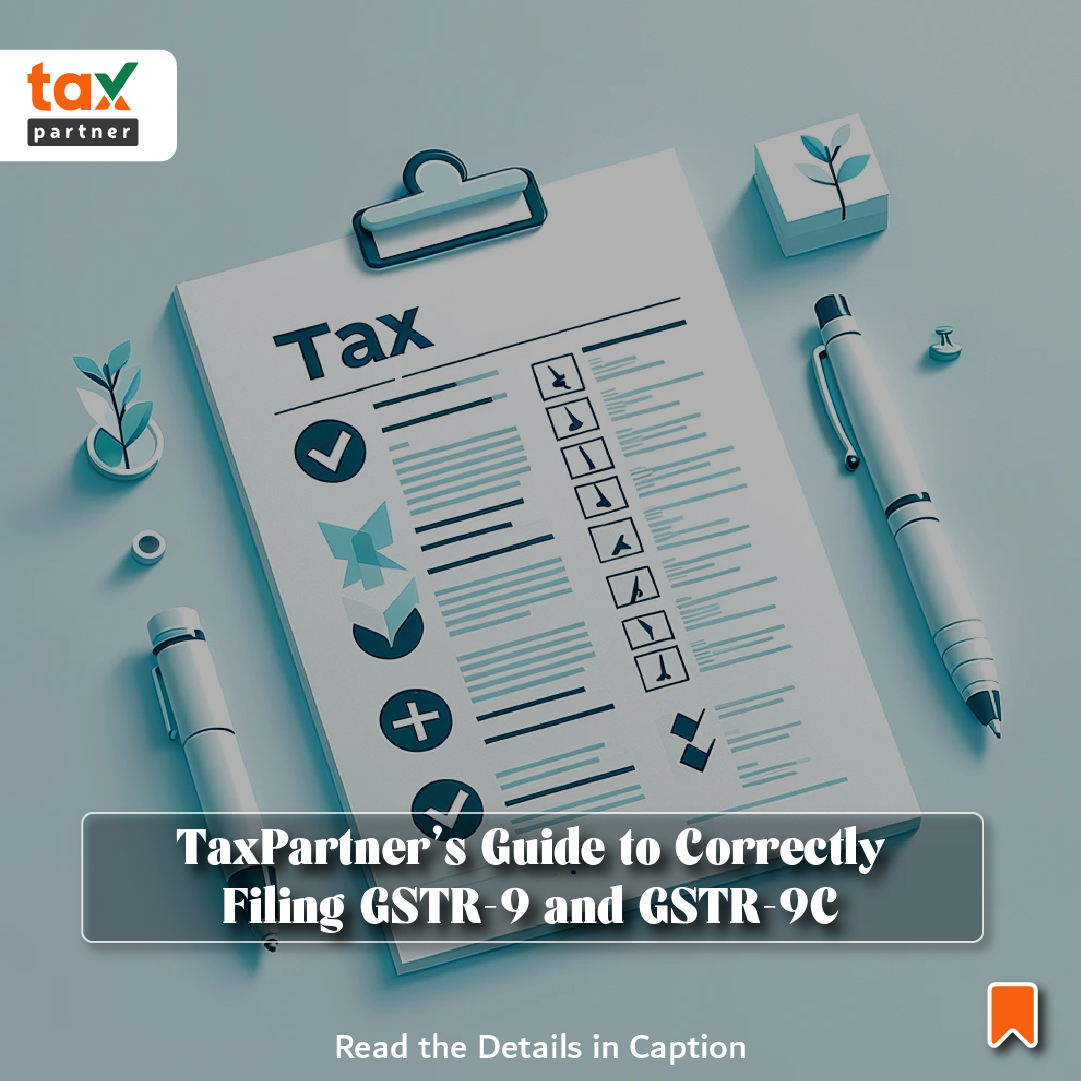Connect with us for all your queries



The implementation of the Goods and Services Tax (GST) in India in 2017 marked a significant shift in the country's tax structure. This new tax regime aimed to simplify the tax process by consolidating multiple taxes into a single unified system. The introduction of GST brought about several benefits, including a streamlined tax process, reduced tax burden on businesses, and increased transparency in taxation. However, it also meant that businesses had to adapt to new compliance requirements, such as filing various returns and statements.
Among the crucial aspects of GST compliance are the accurate filing of GSTR-9 and GSTR-9C. GSTR-9 is an annual return that consolidates the information provided in the monthly or quarterly returns throughout the financial year. On the other hand, GSTR-9C is a reconciliation statement that certifies the accounts and reconciles the figures declared in GSTR-9 with the audited annual financial statements. Filing these forms accurately is of utmost importance for several reasons. It ensures compliance with GST regulations, helps businesses avoid penalties and interest for inaccuracies or delays, and facilitates smooth GST departmental audits.
Despite the benefits of GST, businesses often face challenges during GST departmental audits. These challenges include discrepancies between GSTR-2A and the Input Tax Credit (ITC) claimed, availing ITC from non-genuine taxpayers or vendors with cancelled registrations, ITC reversals due to credit notes appearing in GSTR-2A, mismatches between outward supplies and issued E-way bills, and incorrect classification of goods. Dealing with these issues can be stressful for businesses and may result in queries and demands during audits. Therefore, it is crucial for businesses to understand and adhere to the guidelines for filing GSTR-9 and GSTR-9C to ensure compliance, audit readiness, and mitigate potential risks and complications.
Ensuring the accurate reporting of transactions in the GSTR-9 annual return is crucial for businesses to reflect their true financial activities and maintain compliance with GST regulations. This involves reporting all outward supplies (sales), inward supplies (purchases), and any advances received or paid. By accurately reporting these transactions, businesses can avoid discrepancies that may arise during audits and potential penalties.
Cross-verifying the figures reported in the GSTR-9 with the data filed in the monthly or quarterly GSTR-1 and GSTR-3B, as well as the financial statements, is essential for ensuring accuracy. This process helps businesses identify any inconsistencies early on and ensures that the annual return aligns with previously filed returns. By conducting this cross-verification, businesses can maintain consistency in their reporting and minimize the risk of errors in their annual return.
A detailed analysis of the credit side of expenditures is necessary to ensure that all supplies recorded as expenses are accurately reported in the GSTR-9. By scrutinizing invoices and credit notes related to purchases and expenses, businesses can confirm that these transactions have been correctly accounted for and that the input tax credit (ITC) is appropriately claimed. This meticulous approach to reporting transactions helps businesses maintain compliance and minimize the chances of facing penalties during GST departmental audits.
When it comes to reporting turnover details, it is of utmost importance to ensure that they align perfectly with the figures in the audited financial statements. This cross-verification process is crucial as any discrepancies can lead to audit queries and potential penalties. By accurately matching the turnover details reported in GSTR-9 with the audited statements, businesses can ensure accuracy and consistency in their financial reporting.
Proper classification and reporting of different types of supplies play a vital role in maintaining compliance. It is essential to accurately report zero-rated supplies such as exports, nil-rated supplies, exempted supplies, and non-GST supplies in their respective sections in GSTR-9. Incorrect classification can result in compliance issues and audit discrepancies. By diligently reporting these supplies, businesses can avoid unnecessary complications and ensure smooth operations.
Taxpayers should be aware that delays in filing GSTR-1 and GSTR-3B can attract late fees and penalties. GSTR-1 involves providing details of outward supplies, while GSTR-3B is a summary return for outward supplies and input tax credit. By filing these returns in a timely manner, businesses can avoid incurring additional costs. It is also important to understand how late fees are computed by the GST portal for delayed GSTR-3B filings and to be prepared for any penalties that may be identified during audits. By staying informed and ensuring timely filings, businesses can prevent unnecessary financial burdens.
Throughout the financial year, businesses may need to make changes or corrections to their previously filed GSTR-1 and GSTR-3B returns. It is crucial to accurately incorporate these amendments and adjustments into the annual return. By doing so, businesses can ensure that their annual return is comprehensive and accurate, reflecting any modifications made during the year. This attention to detail helps maintain transparency and reliability in financial reporting.
To support the amendments and adjustments made during the year, it is essential to maintain detailed documentation and backup. This documentation should include all relevant information and evidence to validate the changes made. By keeping thorough records, businesses can provide a clear audit trail and demonstrate the accuracy and legitimacy of their financial reporting. This practice not only helps during audits but also ensures transparency and accountability in business operations.
Accurate and compliant filing of GSTR-9 and GSTR-9C is of utmost importance for businesses operating under the Goods and Services Tax (GST) regime. These annual return and reconciliation statement forms play a vital role in ensuring transparency, accountability, and adherence to GST regulations. By following the comprehensive guidelines provided, taxpayers can effectively manage risks, improve compliance, and protect themselves against potential queries and penalties during GST departmental audits.
The significance of meticulous filing of GSTR-9 and GSTR-9C cannot be emphasized enough. These filings offer a consolidated overview of a business's financial transactions, turnover, tax liabilities, and input tax credit utilization for the entire financial year. Accurate reporting in these forms not only showcases a commitment to compliance but also helps in establishing trust and credibility with tax authorities.
By adhering to the guidelines, businesses can enjoy several benefits, including:
Reduced Risk of Audits and Penalties: Accurate filing of GSTR-9 and GSTR-9C minimizes the chances of discrepancies and errors, thereby lowering the risk of audits and penalties. Thorough reconciliation of financial data and adherence to GST provisions contribute to compliance and help avoid potential penalties.
Enhanced Compliance and Transparency:Following the guidelines promotes transparency and integrity in tax reporting. It ensures that all transactions are reported accurately, and tax liabilities are calculated and paid correctly. This fosters trust between businesses and tax authorities and contributes to a robust compliance culture.
Proactive Measures and Regular Updates:Encouraging proactive measures such as maintaining proper documentation, seeking professional assistance when needed, staying updated with GST laws, and utilizing technology solutions is crucial. Regular updates on changes in GST laws and filing requirements help businesses stay compliant and adapt to evolving regulatory landscapes.
By adhering to the guidelines for filing GSTR-9 and GSTR-9C, businesses can effectively manage risks, improve compliance, and maintain a strong relationship with tax authorities. It is essential to prioritize accurate and compliant filing to ensure the smooth operation of businesses under the GST regime.
1. What is GSTR-9?
GSTR-9 is the annual return that every registered GST taxpayer must file. It consolidates all monthly/quarterly returns filed during the financial year.
2. Who needs to file GSTR-9?
All registered taxpayers under GST, except composition taxpayers, casual taxable persons, non-resident taxable persons, and Input Service Distributors (ISDs), must file GSTR-9.
3. What is GSTR-9C?
GSTR-9C is a reconciliation statement between the annual return in GSTR-9 and the audited financial statements. It is required to be filed by taxpayers with an annual turnover exceeding ₹5 crores.
4. Who needs to file GSTR-9C?
Taxpayers whose annual turnover exceeds ₹5 crores in a financial year must file GSTR-9C along with their annual return GSTR-9.
5. What is the due date for filing GSTR-9 and GSTR-9C?
The due date for filing GSTR-9 and GSTR-9C is December 31st of the subsequent financial year, unless extended by the government.
6. Can GSTR-9 be revised after filing?
No, GSTR-9 cannot be revised once it is filed. Therefore, it is essential to ensure accuracy before submission.
7. What details are required in GSTR-9?
GSTR-9 requires details of outward and inward supplies, ITC availed, taxes paid, amendments made, and any refund or demand details, among others.
8. How should discrepancies in turnover be handled in GSTR-9C?
Discrepancies should be identified, explained, and reconciled in GSTR-9C. Supporting documents and justifications should be provided for audit purposes.
9. What is the penalty for late filing of GSTR-9?
Late filing of GSTR-9 attracts a late fee of ₹200 per day (₹100 CGST and ₹100 SGST), subject to a maximum of 0.25% of the taxpayer’s turnover in the relevant state or union territory.
10. What is the role of E-way bills in filing GSTR-9?
E-way bills must be reconciled with sales and purchase records to ensure that all goods movements are accurately reported in GSTR-9, reducing the risk of discrepancies and audit issues.
11. How can taxpayers ensure the accuracy of ITC claims in GSTR-9?
Taxpayers should reconcile ITC claimed in GSTR-3B with ITC available in GSTR-2A/2B, verify the authenticity of suppliers, and ensure compliance with ITC eligibility criteria.
12. Are there any exemptions from filing GSTR-9C?
Yes, taxpayers with an annual turnover of ₹5 crores or less are exempt from filing GSTR-9C.
13. What are common errors to avoid while filing GSTR-9?
Common errors include incorrect reporting of turnover, mismatches in ITC, failing to reconcile with financial statements, and not incorporating amendments and credit/debit notes.
14. Can taxpayers use software for filing GSTR-9 and GSTR-9C?
Yes, taxpayers are encouraged to use reliable GST compliance software to automate and streamline the filing process, reducing manual errors and ensuring accuracy.
15. Why is professional assistance recommended for GSTR-9 and GSTR-9C filing?
Professional assistance ensures compliance with GST laws, helps navigate complex transactions, minimizes the risk of errors, and provides expert guidance on addressing discrepancies and audits.
Tax Partner is India’s most reliable online business service platform, dedicated to helping you in starting, growing, & flourishing your business with our wide array of expert services at a very affordable cost.